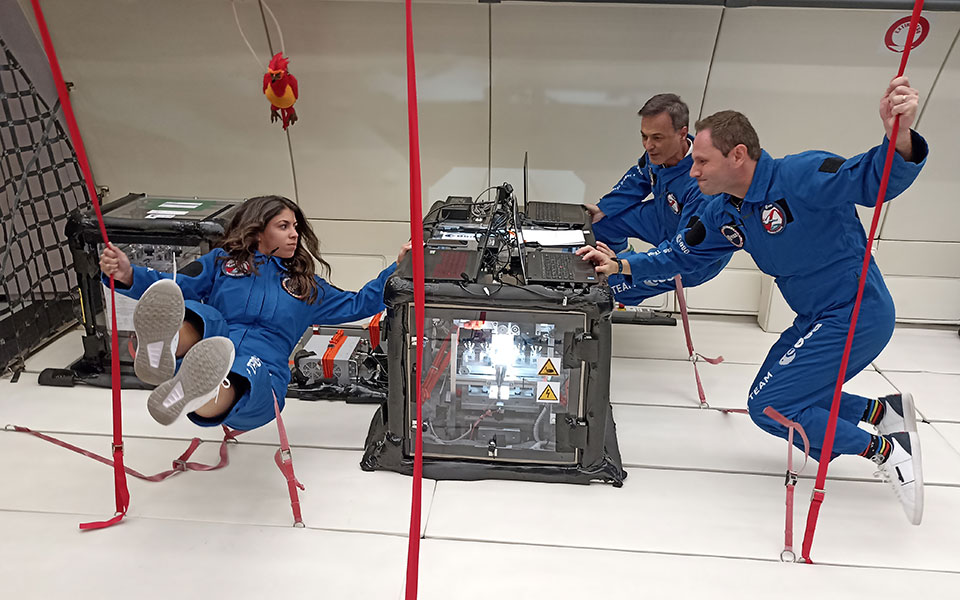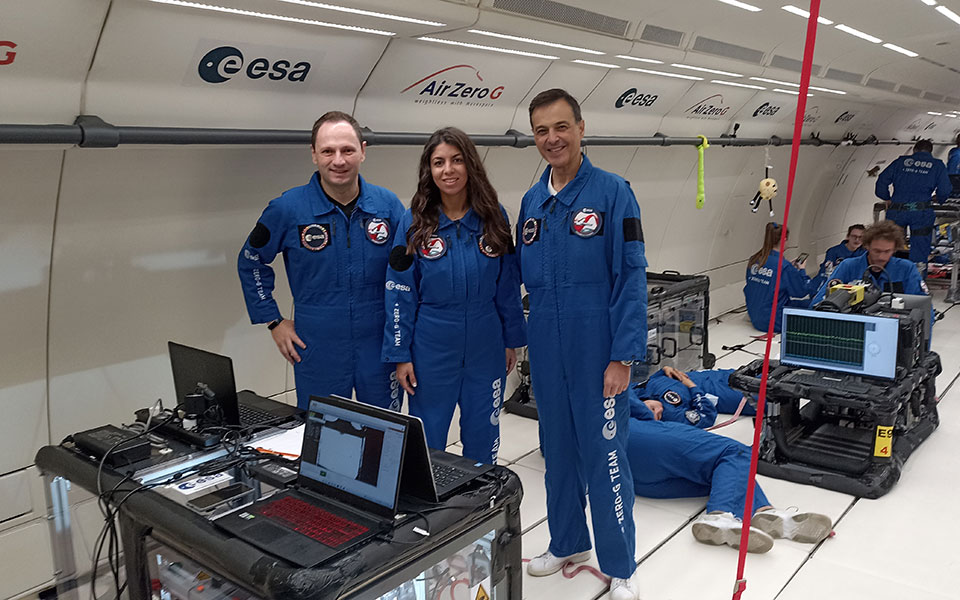
The experiment in weightlessness was carried out by the scientific group of the Aristotle University in Thessaloniki.
Over the Atlantic, starting from Bordeaux, France, a special configuration aircraft (Airbus A310) operating 93 consecutive steep ascents and descents following the flight path in the form of a parabola was given to the group of dynamics of multiphase systems of the chemical faculty of AUTS, headed by a professor of chemistry Theodori Carapanziothe ability to test in weightlessness (as well as in space) the accuracy of what he studied and designed in the university laboratory.
Experiment”Low g emulsionswas successfully completed on October 27th. It was carried out as part of the European Space Agency’s Parabolic Flights campaign and concerned the study of the phenomena that determine the stability of emulsions that are widely used in various fields (insecticides, polishes, lubricants, paints, varnishes, as well as in foods, drugs, pesticides).
The experiment was purely Greek, both in terms of the design and construction of the experimental device, and in terms of the scientific team that operated the device inside and outside the aircraft during flights.
The experiment was carried out in the context of the participation of the AUTH team in the European Space Agency’s Very Large Emulsion Research Program (SMD-PASTA), which has been ongoing for several months on the International Space Station in orbit. around the Earth with the participation of teams from universities and research institutes in the US, Germany, France, Italy and Japan.

“AUTH Team Experience with 5 Hour Zero Gravity”
The AUTH team is considered one of the most experienced in Europe, having completed a total of nine ESA parabolic flights with a total zero gravity time of over 5 hours.
In this Parabolic Flight campaign, the AUTH pilot team, apart from Mr. Karapantzios, consisted of flight operators. Dr. Sotiris Evgenides (Chemical) and Angelica Chondrow (Ph.D., AUTH) and from the ground support team Mr. Margaritis Kostoglu (Professor of the Faculty of Chemistry of AUTH) and Mr. Chilipira rose (technician AVT).
“The Hellenic Mission, with its participation in an advanced research program, conveys a strong message to the scientific – and not only – community inside and outside the borders: that Greece has the appropriate specialized scientific capacity to conduct complex experiments and get high results. – high-quality scientific work.
But at the same time, a message is also being given to our youth that Greece has not lost its ability to be a place of opportunity, and this has strong symbolism as a means to stop the wave of scientific capital flight that our country has been experiencing in recent years,” said Mr. Karapantzios.
Describing the feeling of weightlessness that occurs during parabolic flights, he explained that the element of hypertension dominates both during and after the completion of the flight. All groups participating in these experiments receive special training, as well as preventive medications for side effects that can cause a sharp change in gravity conditions in the human body.
“Participating teams are selected by the European Space Agency after an evaluation based on rigorous scientific criteria, and the performance and safety of each experiment is verified by specialized personnel who visit the teams in their labs throughout their training,” said Mr. Karapantzios. .
The goal of each parabolic flight experiment is to take advantage of 25 seconds of weightlessness in each of the 93 parabolic flights completed over a total of 3 days of flight to study the natural phenomenon of interest. And if the average person is interested in what someone manages to observe during these 25-second intervals, Mr. Karapantzios assured that there is more than enough time to study the phenomena associated with the interaction of droplets and bubbles during dispersion and that the team is also on this mission received valuable information for her research project.
Each parabolic flight campaign involves about 10 science teams and each campaign consists of seven days of final test experiments followed by three days of flight. The previous participation of the AUTH team in a parabolic flight took place in May 2017, and the next one in which they will take part is scheduled for October 2023.

“The Importance of the Experiment”
Regarding the importance of the AUTH experiment, Mr. Karapantzios pointed out that “in principle, it lies in the scientific significance of the results obtained under weightless conditions. In particular, experimental results have shown the mechanisms by which it is possible to prepare emulsions of particular stability even when using a small amount of chemicals (surfactants), provided that appropriate emulsification conditions are chosen.”
Experiments on the AUTN experimental setup concerned the study of the dynamic behavior of drops of an organic liquid (oil phase) in a continuous aqueous phase. An emulsion is defined as a dispersion of droplets of one liquid in another liquid without the two liquids mixing with each other.
Under terrestrial gravity, due to the difference in density between the two liquids of the emulsion, buoyancy leads to a rapid separation into two distinct layers, one of oil and one of water, making it impossible to study the movement and interaction of droplets.
Conversely, under weightless conditions, gravitational effects are eliminated. This makes it possible to study the dynamic behavior of droplets and their interactions (coalescence and droplet aggregation), which contributes to a better understanding of the mechanisms of emulsion destabilization and will lead to new data that will improve the quality of industrial products in the form of an emulsion.
1) concentration of emulsifier (surfactant),
2) oil-water phase ratio and
3) frequency and duration of piston movement causing emulsification.
All of the above affects the size distribution of oil droplets in the resulting emulsions and, consequently, their stability.
Three diagnostic methods were used in the experiments: a high-speed video camera capable of recording collision events of neighboring drops in milliseconds, a high-resolution camera capable of automatically capturing images at specified time intervals, and an electrical impedance spectroscopy setup to control the time evolution of the volume fraction of the dispersed phase (oil phase droplets).
MONKEY BEE
Source: Kathimerini
Robert is an experienced journalist who has been covering the automobile industry for over a decade. He has a deep understanding of the latest technologies and trends in the industry and is known for his thorough and in-depth reporting.